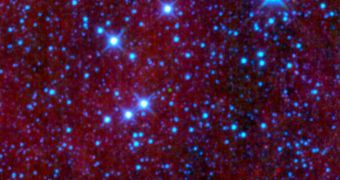Scientists at the American space agency are thrilled to announce that one of their telescopes managed to discover signs of the existence of an ultra-cold star, called a brown dwarf. These objects cannot be readily classified as either stars or enormous gas giants.
NASA used the Wide-field Infrared Survey Explorer (WISE) for the job. The observatory has concluded its primary science mission, and is now dedicating its time to discovering near-Earth objects (NEO), looking for asteroids and comets, and surveying the sky for brown dwarfs.
In one of its investigations, the telescope stumbled upon a tiny, ultra-cold star that was all alone in its corner of the Universe. Scientists managing the observatory could not find any companion for it.
Because WISE uses several infrared detectors to conduct its studies – each producing visual data of a different color – the newly-found brown dwarf is clearly visible in the attached photo, as the green dot in the center of the view.
“The brown dwarfs jump out at you like big, fat, green emeralds,” says WISE deputy project scientist Amy Mainzer, who is based at the NASA Jet Propulsion Laboratory (JPL), in Pasadena, California.
She explains that detectors only produced data in three colors, green, blue and red. The methane in the brown dwarf's atmosphere absorbs blue light, while the object's low temperatures don't allow for it to appear red.
As such, the only color that remains is green. JPL researchers say that brown dwarfs mostly contain chemical elements such as methane, hydrogen sulfide, and ammonia.
Astronomers say that this mix most likely makes the brown dwarfs smell pretty bad. “If you could bottle up a gallon of this object's atmosphere and bring it back to Earth, smelling it wouldn't kill you, but it would stink pretty badly – like rotten eggs with a hint of ammonia,” Mainzer reveals.
She explains that the mechanisms through which these space objects develop are identical to those that end up producing stars, but up to a certain point.
When hydrogen clouds of insufficient mass collapse, the friction that permeates the gas is not strong enough to jump-start a fusion reaction in the hydrogen atoms. As such, the resulting ball of gas goes not ignite to produce a new star.
The result is a body that resembles both a small star and a very large gas giant, but which does not feature any of the prominent characteristics either are known for. These objects are also very difficult to find.
NASA experts are currently using WISE to scan the skies for more such objects, including those that may be closest to us. They are also looking for the coolest, in hopes that this would allow them to gain more insight into how atmospheres develop.
“They're a great test of our understanding of atmospheric physics of planets, since they don't have solid surfaces, and there's no big, bright sun to get in the way,"” adds JPL postdoctoral fellow Michael Cushing.
Details of the new discovery are scheduled to appear in an upcoming issue of the esteemed Astrophysical Journal.

 14 DAY TRIAL //
14 DAY TRIAL //